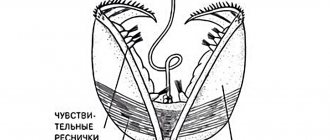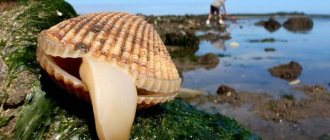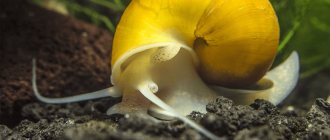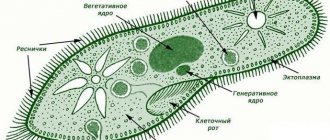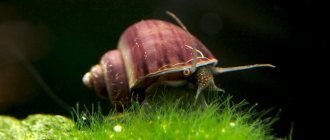The mussel clam is a bivalve edible shellfish that lives in the depths of oceans and seas, as well as freshwater rivers and lakes. There are more than twenty thousand species of these invertebrates, but only a few (belonging to the class Mytilus, Perna, Crenomytilus) are the most important objects of fishing and consumption.
Do you like mussels?
- Yes 89%, 2265 votes
2265 votes 89%2265 votes - 89% of all votes
- No 6%, 154 votes
154 votes 6%
154 votes - 6% of all votes
- I don't eat seafood 5%, 139 votes
139 votes 5%
139 votes - 5% of all votes
Total votes: 2558
08.10.2019
- Yes 89%, 2265 votes
2265 votes 89%2265 votes - 89% of all votes
- No 6%, 154 votes
154 votes 6%
154 votes - 6% of all votes
- I don't eat seafood 5%, 139 votes
139 votes 5%
139 votes - 5% of all votes
Total votes: 2558
08.10.2019
×
You or from your IP have already voted.
Demand on the global seafood market exceeds supply. That is why the number of aquaholdings (seaside farms) whose activities are related to the cultivation of this delicacy is growing. Let's get acquainted with seafood, find out what sea mussels are.
Origin of the species and description
Photo: Midia
Mussel is a common name that applies to members of the bivalve mollusk families that live in fresh and salt water. Members of these groups have a common shell with an elongated outline, which is asymmetrical in comparison with other edible mollusks, the outer shell of which has a more rounded or oval outline.
The word “mussel” itself is colloquially used to refer to mollusks of the Mytilidae family, most of which live on the open shores of the coastal zone of water bodies. They are attached by strong byssalline threads to a solid substrate. Some species of the genus Bathymodiolus are equipped with colonized hydrothermal vents associated with ocean ridges.
Video: Mussel
Most mussels have narrow but long shells and an asymmetrical, wedge-shaped shell. The outer colors of the shells are dark, often dark blue, brown or blackish, while the inner lining is silver and somewhat pearlescent. The name "mussel" is also used for freshwater bivalves, including freshwater pearl mussels. Mussels living in fresh water belong to different subclasses of bivalve mollusks, although they have some superficial similarities.
Freshwater mussels of the family Dreissenidae are not classified in previously designated groups, even if they resemble them in shape. Many Mytilus species live attached to rocks using a byssus. They are classified as Heterodonta, a taxonomic group that includes most species of bivalve mussels called “clams.”
Chemical composition
Mussel meat is characterized by nutritionists as an excellent source of powerful and high-quality proteins. In terms of quantity and quality of protein, it surpasses even chicken eggs, but there is very little fat and carbohydrates in this mollusk. Shell meat also contains taurine and arginine, which are strong natural aphrodisiacs.
In mussels, the set of useful microelements is minimal, but they are in fairly high concentration. This:
- calcium;
- magnesium;
- manganese;
- boron;
- potassium and phosphorus;
- cobalt;
- sodium;
- iodine;
- iron.
Also, mussels are rich in vitamins: A, B1, B2, B6, B12, E, D3, C and PP.
Appearance and features
Photo: What a mussel looks like
The mussel is characterized by a smooth, unequal outer shell, usually purple, blue or dark brown, with concentric growth lines. The inside of the case is pearly white. The inside of the valves is whitish-yellow in color, and the posterior adductor scar is much larger than the anterior adductor scar. Fibrous brown filaments extend from the closed shell to attach to the surface.
The length of mature shells is about 5-10 cm. They have an oblong oval shape and consist of a right and left valve, which are held together by an elastic muscular ligament.
The shell consists of 3 layers:
- upper made of organic material;
- medium thick layer of lime;
- inner silvery-white pearlescent layer.
Mussels have a sphincter, which is located in the soft part of the shell and other organs (heart, stomach, intestines, kidney). With the help of the sphincter, the mussel can tightly close the shells in case of danger or drought. Like most bivalves, they have an organ called a leg. Freshwater mussels have a muscular foot, large with a byssal gland, and usually axe-shaped.
Interesting fact: A foreign body that finds itself between the valve and the mantle is enveloped on all sides by mother of pearl, thus forming a pearl.
Iron, with the help of egg whites contained in the mussel and iron filtered from the sea, produces byssal threads that the mussel can cling to surfaces. The leg is used to pull the animal through the substrate (sand, gravel or silt). This occurs by pushing the leg through the substrate, widening the passage, and then pulling the rest of the animal with the shell forward.
In sea mussels, the leg is smaller and tongue-like, with a small depression on the ventral surface. From this pit a viscous and sticky secretion is released, which falls into the groove and gradually hardens upon contact with sea water. Which forms unusually hard, strong, elastic threads with which the mussel attaches to the substrate, remaining motionless in places with increased flow.
How to choose
Despite the apparent simplicity and unpretentiousness of this seafood, the world has long developed strict rules and recommendations for choosing a product:
- The main thing in casting: integrity control. Each mollusk valve must not have deformations, damage, scratches or cracks. Particular attention should be paid to the closedness of the shells: slightly opened mussels are poorly (short-lived) stored;
- a good indicator of the freshness of the product is the characteristic click when opening the shell (when purchasing freshly caught shellfish). The silently opening shell is spoiled (expired);
- Frozen shellfish should not stick together into a solid shell of ice. Excess freezing often hides logistics and storage problems;
- The body color of the mollusk should be white, cream or orange. Any deviations in color (darkening, spotting, etc.) mean the product is not fresh. Quality delicacies look beautiful;
- the flap delicacy can smell only of the sea or iodine. Any other odors and fragrances are a signal to refuse the purchase;
- Excessively heavy mussels should be treated with suspicion: there may be sand inside the shell;
- There are several types of mussels available on the market: frozen, canned, fresh. In order not to spoil the gastronomic euphoria, you should take product casting seriously. Visit only reputable retail outlets, check the expiration dates indicated on the packaging, and refuse to purchase at the slightest doubt.
Where does the mussel live?
Photo: Mussels in Russia
Mussels are found in coastal areas of the North Atlantic Ocean, including North America, Europe and the northern Palaearctic. They are found from the White Sea in Russia to southern France, throughout the British Isles, northern Wales and western Scotland. In the western Atlantic, M. edulis occupies the southern Canadian maritime provinces to North Carolina.
Marine mussels are found in the middle and lower intertidal zones of the world's relatively temperate seas. Some mussels are found in tropical intertidal zones, but not in such large numbers.
Some species of mussels prefer salt marshes or quiet bays, while others enjoy the crashing surf, covering the coastal stones washed with water. Some mussels have colonized the depths near hydrothermal vents. The South African mussel does not stick to rocks, but lurks on sandy beaches, perching above the surface of the sand to consume food, water and waste.
Fun Fact: Freshwater mussels live in lakes, canals, rivers and streams all over the world, excluding polar regions. They constantly need a source of cool, clean water. Mussels choose water containing minerals. They need calcium carbonate to build their shells.
The mussel can resist freezing for several months. Blue mussels acclimate well to a temperature range of 5 to 20 °C, with an upper sustainable thermal tolerance limit of about 29 °C for adults.
Blue mussels do not thrive in water salinities less than 15%, but can withstand significant environmental fluctuations. Their depth ranges from 5 to 10 meters. Typically, M. edulis is found in subtidal and intertidal layers on rocky shores and remains permanently attached there.
Now you know where the mussel is found. Let's see what this mollusk eats.
What does a mussel eat?
Photo: Black Sea mussels
Marine and freshwater mussels are filter feeders. They have two holes. The water passes through the inlet, where the eyelash hairs create a constant flow of water. Thus, tiny particles of food (plant and animal plankton) adhere to the mucous layer of the gills. The eyelashes then propel gill mucus containing food particles into the mussel's mouth and from there into the stomach and intestines, where the food is finally digested. Undigested residues are again removed from the outlet along with the breathing water.
The main diet of mussels consists of phytoplankton, dinoflagellates, small diatoms, zoospores, flagellates and other protozoa, various single-celled algae and detritus filtered from the surrounding water. Mussels are suspension filter feeders and are considered scavengers, collecting anything in the water column that is small enough to absorb.
The usual diet of mussels includes:
- plankton;
- detritus;
- caviar;
- zooplankton;
- seaweed;
- phytoplankton;
- microbes
Sea mussels are often found clumped together on wave-washed rocks. They are attached to rocky outcrops by their byssus. The habit of sticking together helps to hold mussels when exposed to strong waves. During low tide, individuals in the middle of the aggregation are subject to less fluid loss due to the capture of water by other mussels.
Beneficial features
Thanks to the protein contained in mussels, seafood is suitable for feeding male athletes, acting as a protein that should be taken after training. Girls and women can also eat shellfish while on a diet to lose weight, since mussels, with their low calorie content, have such beneficial properties as nutritional value.
Benefits for the human body from systematic consumption of seafood:
- the structure of nails and hair is strengthened;
- bones are strengthened;
- the risk of arthritis is reduced;
- blood cholesterol levels decrease;
- blood flow increases;
- toxins and salts are removed;
- the fermentation process in the intestines is prevented;
- the functioning of the gastrointestinal tract is normalized;
- the risk of cancer is reduced;
- potency increases;
- teeth are strengthened, the process of crumbling is prevented;
- irritability decreases, symptoms of apathy disappear;
- the level of hemoglobin in the blood increases;
- metabolism accelerates.
Mussels have a tonic effect on the body and are beneficial for people suffering from heart disease.
Features of character and lifestyle
Photo: Sea mussels
Mussels are a sessile species, constantly settling on substrates. Mature mussels prefer to spend their time sedentary, so their leg loses motor function. In loose substrates, younger individuals suffocate older mussels on which they settle.
Interesting fact: Mussels are used as bioindicators to monitor the state of the environment in fresh and sea water. These mollusks are very useful because they are distributed throughout the world. Their characteristics ensure that they demonstrate the environment in which they are found or placed. Changes in their structure, physiology, behavior or abundance indicate the state of the ecosystem.
Special glands secrete strong protein threads with which they are secured to stones and other objects. River mussels do not have such an organ. In a mussel, the mouth is located at the base of the leg and is surrounded by lobes. The mouth is connected to the esophagus.
The mussel is highly resistant to elevated sediment levels and helps remove sediment from the water column. Mature mussels provide habitat and prey for other animals and provide substrate for algal attachment, increasing local diversity. Mussel larvae are also an important food source for plantation animals.
Mussels have special devices to assist with geolocation and orientation. Mussels have chemoreceptors that can detect the release of gametes. These chemoreceptors also help juvenile mussels avoid temporarily settling on substrates near mature mussels, presumably to reduce competition for food.
The lifespan of these mollusks can vary significantly depending on where they are attached. Settlement in more open coastal zones makes individuals significantly more vulnerable to predators, mainly birds. Mussels that settle in exposed areas can experience mortality rates of up to 98% per year. Drifting larval and juvenile stages suffer the highest mortality rates.
The most popular oysters on the market
Potential buyers first pay attention to several factors when purchasing oysters:
- Breeding place. Of course, sea shellfish are in great demand. In terms of price, 1 oyster grown in a natural environment is equal to 9 oysters grown at home. However, the taste of domestic oysters can be seriously influenced by adjusting salinity, temperature, and so on.
- Taste. Tasty specimens grow in waters with a salt content of 20–30%. When these indicators are exceeded, the meat already becomes tough. If there is no salt in the water or less than 12%, then the mollusks will die.
- Collection time. Oysters that are not pleasant to the taste are collected in the summer. During this period, the reproduction phase occurs, so the taste of the meat is not the most pleasant.
Oyster farming can be done both at home and in natural conditions. This product is in demand, so the costs will be worth it.
Social structure and reproduction
Photo: Mussels
Each spring and summer, females lay five to ten million eggs, which are then fertilized by males. Fertilized eggs develop into larvae, which are 99.9% consumed by predators during their four-week development into a young mussel.
However, after this "selection" there are still about 10,000 young mussels left. They measure around three millimeters and often drift out to sea for several hundred kilometers before settling at around five centimeters in coastal areas.
Fun Fact: The reason mussels live in such large colonies is because males are much more likely to fertilize the eggs. After the larvae float freely for about four weeks as plankton, they attach themselves to rocks, piles, shells, hard sand and other shells.
Mussels have separate male and female individuals. Sea mussels are fertilized outside the body. Beginning in the larval stage, they drift for up to six months before they can settle on a solid surface. They are able to move slowly, gluing and detaching the byssal threads to achieve a better position.
Freshwater species reproduce sexually. The male releases sperm into the water, which enters the female through the flowing hole. After fertilization, the eggs reach the larval stage and temporarily parasitize the fish, holding on to the fins or gills. Before they emerge, they grow in the female's gills, where oxygen-rich water constantly circulates around them.
The larvae survive only when they find the right host - a fish. Once the larvae attach, the fish's body reacts by enveloping them in cells that form a cyst, where they remain for two to five weeks. Growing up, they free themselves from the owner, sinking to the bottom to begin an independent life.
Methods of breeding shellfish
You can find many options where you can grow this delicacy. Some of them are budgetary, some require large amounts of money and time.
- Cages. One simple option is to install a cage in the water. Such structures are installed near the coasts of the Azov and Black Seas. It can also be placed in a river for breeding fresh shellfish. Rivers provide suitable conditions for reproduction.
- Closed water supply installations. You can install such a device at home for breeding mussels. Can be placed in a separate pool for breeding oysters. At home, you need to constantly monitor the quality of water and the availability of food.
- Swimming pools. Such separate pools can be installed in any room: in the utility room, garage, warehouse, basement. Favorable conditions have been created for the development of oysters in such containers.
- Pond. If you want to do this business in an artificial pond, then there are a number of nuances. For example, not every region's climate will be suitable for cultivation. However, you can cover the pond with a greenhouse to create comfortable conditions. A pond with 120 cubic meters of water can cost a future businessman 200,000 rubles.
- Aquarium. Perhaps the most budget option. You can install such an installation in a room in any apartment. This method is also suitable for sampling and test dilution. The aquarium must have a water filter, and food will also have to be diluted in a separate container.
Natural enemies of mussels
Photo: What a mussel looks like
Mussels are most often found in large aggregations, where they are somewhat protected from predation by virtue of their numbers. Their shell acts as a protective layer, although some species of predators are capable of destroying it.
Natural predators of mussels include starfish, which wait to open the mussel's shell and then devour it. Numerous vertebrates eat mussels, such as walruses, fish, herring gulls and ducks.
Not only can they be caught by humans for consumption, they are also used to make fertilizer, they serve as fishing bait, food for aquarium fish and from time to time for anchoring shingle banks, as in the English county of Lancashire. Mild winters complicate the situation because there are almost always many predators of young mussels.
The most famous predators of mussels include:
- flounder (Pleuronectiformes);
- snipe (Scolopacidae);
- seagulls (Larus);
- crows (Corvus);
- dye's purple (N. lapillus);
- starfish (A. rubens);
- green sea urchins (S. droebachiensis).
Some predators wait until the mussel is forced to open its valves to breathe. The predator then pushes the mussel's siphon into the gap and opens the mussel so it can be eaten. Freshwater mussels are eaten by raccoons, otters, ducks, baboons and geese.
Business plan
To organize activities, you need to purchase the necessary equipment and develop a detailed plan that takes into account all costs, income and payback periods.
In this case, it is necessary to take into account the following costs:
- renting a section of coastline (if mussels will be grown directly in the sea);
- construction of structures, collectors and carriers;
- Equipment for the mussel processing workshop: it must contain machines for blanching and cooking mussels, and washing equipment.
Experts indicate that all costs for organizing a business, including staff salaries, are about $20,000.
The business pays off in about three years. The profitability indicator will be 20%.

